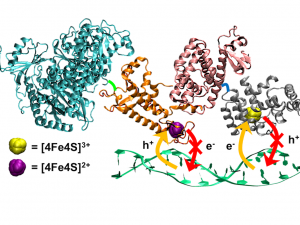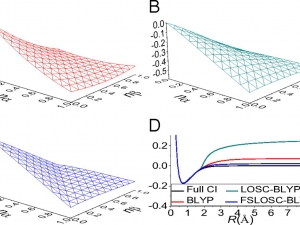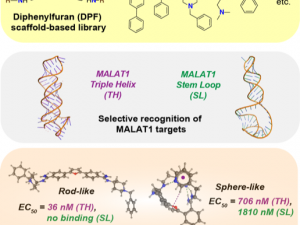We are thrilled to announce that Prof. Matt Becker will join the Department to further expand functional biomaterials at Duke! We look forward to welcoming Matt and his research group on August 1! read more about Prof. Matt Becker to Join Duke Chem! »
Professor Emily Derbyshire has been highlighted by The Scientist! Find out what sparked her interest in studying Malaria in the feature here. read more about Prof. Emily Derbyshire Highlighted for Combating Liver-Stage Malaria »
Prof. Amanda Hargrove was named one of 34 prominent scientists moving Biochemistry into the future! The Biochemistry "Future of Biochemistry: The International Issue" highlights Amanda's work toward RNA molecular recognition in Part Four of this special issue. Congratulations to Amanda and her lab on their recognition! Read more on their exciting research in a recent edition of Biochemistry, available here. read more about Hargrove is Taking Biochemistry to the Next Level »
Professor Kevin Welsher has received the prestigious NSF CAREER Award! Kevin’s research group will be developing "target-locked" microscopy tools to follow the rapid motions of single proteins and cellular cargo transport machinery within cells in real time. Congratulations to Kevin and his research group on receipt of this prominent award! read more about Prof. Kevin Welsher Receives NSF CAREER »
Congratulations to Dr. Felix Nwogbo! Felix has been named as a recipient of the 2019 Samuel DuBois Cook Society Awards, which recognize individuals who routinely enrich the lives of people in the Duke community and contribute to the betterment of all people, above and beyond their given roles. Felix shares this award with Ms. Dionna Gamble, a graduate student in MGM. read more about Dr. Felix Nwogbo Receives Samuel DuBois Cook Award »
The Malcolmson lab has recently shown that gem-difluoroazadienes can serve as a novel building block for the synthesis of chiral alpha-trifluoromethyl amines via the vicinal fluoro-functionalization of its alkene. Alpha-trifluoromethyl amines are important medicinal motifs as the CF3 group serves as a proteolysis-resistant surrogate for an amide. In this work, the research team has demonstrated that AgF addition across the azadiene is catalyzed by a phosphine, leading to a metastable alpha-CF3 azaallyl–silver… read more about Malcolmson Lab Demonstrates New Route to Alpha-Trifluoromethyl Amines »
The Hargrove Lab has created a general, high throughput technique for screening small molecule probes against different RNA targets using a fluorescence indicator displacement (FID) assay. Learn more about their fast and convenient method to simultaneously evaluate small molecule libraries against different RNA targets and classify them based on affinity and selectivity patterns in a recent Organic & Biomolecular Chemistry article here. read more about Hargrove Lab Screens Against RNA Targets »
Congratulations to Professor David Beratan, the 2018 Murray Goodman Memorial Prize recipient! Professor Beratan will receive the award from Biopolymers in recognition of his seminal contributions to biophysics and their impact on our understanding of charge transport in biomolecules. David will be honored at a symposium in association with the Division of Biological Chemistry of the American Chemical Society (ACS) at the ACS Spring meeting and will present a lecture as well. Congratulations, David,… read more about David Beratan Receives the Murray Goodman Memorial Prize! »
Graduate student Meredith Barbee and co-workers in the Craig lab and at Texas State have used a mixture of classical physical organic methodology and contemporary single molecule spectroscopy to tease out mechanistic details of a reaction occurring under large mechanical forces. Their paper in JACS has been highlighted by the journal here. read more about Reaction Mechanisms in Single Molecule Mechanochemistry »
Agostino Migliore, Darius Teo and additional members of the Beratan Lab, with collaborators at USC, take an important step towards understanding intracellular redox signaling at the core of DNA repair and replication processes. Experiments suggesting a role for DNA charge transport in mediating such signaling have been the subject of a heated debated in recent literature. The lab has demonstrated that charge transfer between a [4Fe4S] protein and a nucleic acid duplex is unidirectional. This… read more about Unraveling Important Constraints on the Mechanisms for Redox Signaling in DNA Replication and Repair »
Ten theoretical chemists at Duke are launching a summer undergraduate research program for rising seniors, beginning in the summer of 2019. Undergraduate students studying in North America (US, Mexico, and Canada) are invited to apply. The program will run for about seven weeks and will provide a research stipend, housing, and a travel allowance. Students will engage in research, and will also have tutorials on theoretical methods and on research challenges at the frontiers of theoretical chemistry.… read more about Chemistry Hosting 2019 Summer Undergrad Research Experience in Theory and Computation »
Associate Dean Aaron Saguil (Chemistry '95 Grad!) stands with four recent Duke graduates as they begin their medical training at the Hébert School of Medicine at the Uniformed Services University. From left: Thomas I. (2017 Chem minor); Eli M. (Biomedical Engineering '17); Gabrielle F. (2017 Chem Major); Dean Saguil; and Elan B-R. (Biomedical Engineering, 2007). Wonderful to see Duke alumni uniting and thanks for sharing the pic! read more about Chem Alumni Unite at Uniformed Services University »
The static correlation error inherent in commonly used density functional approximations (DFAs) has seriously hindered the application of density functional theory (DFT) to strongly correlated systems. Here, an effective fractional-spin correction against the important issue of static/strong correlation in DFT is developed. With this, the flat-plane behavior of various DFAs is largely restored, and the potential energy curves of dissociation of ionic species, single bonds, and multiple bonds are properly described, which… read more about Yang Lab Describing Correlation with Fractional-spin Correction in DFT »
The Department is seeking a colleague at the Assistant or Associate Professor rank with strong commitments to research, teaching, and embracing a diverse and inclusive community of scholars. Candidates should have research interests in experimental approaches in Inorganic or Physical Organic Chemistry, particularly those with a multidisciplinary reach. Learn more about this exciting opportunity and submit an application at Academic Jobs Online. read more about Chemistry is Hiring! »
While the majority of small molecule chemical probes and drugs to date modulate the action of proteins, the Hargrove Lab is searching for small molecules that selectively engage binding pockets of RNA. In their most recent work, the group discovered the first ligands for the triple helix structure of an oncogenic long non-coding RNA MALAT1. The synthesis, evaluation and computational analysis of these novel small molecules revealed trends between small molecule shapes and their binding behavior. Together, these… read more about Hargrove Lab Searches for Small Molecules that Selectively Engage Binding Pockets of RNA »
The enantioselective and intermolecular addition of nucleophiles to internal olefins is a challenging process due to the typically low reactivity of these substrates. Hydroaminations of 1,4-disubstituted dienes present further challenges as several product regioisomers may be obtained and reactions tend to be reversible, leading to erosion of enantiopurity of products over time. The Malcolmson lab has now demonstrated that Pd–PHOX catalysts facilitate the regio- and enantioselective hydroamination of internal dienes with… read more about Malcolmson Lab Illustrates Enantioselective Hydroamination of Internal Dienes »
Non-coding RNAs have been identified that are essential for cellular regulation and that are misregulated in disease; however, the development of tools to study these RNAs has been challenging. To harness existing knowledge into the development of RNA-targeted chemical probes, the Hargrove lab examined the RNA targets, design and discovery strategies, and characterization techniques for ligands in the RNA-targeted BIoactive ligaNd Database (R-BIND). Further, the survey… read more about Hargrove Lab Hopes to Expedite the Discovery of RNA-targeted Ligands »
The National Science Foundation is funding the new Center for the Chemistry of Molecularly Optimized Networks (MONET) as a Phase I Center for Chemical Innovation. Led by Duke and featuring prominent chemists at MIT and Northwestern, MONET informs strategies to bring remarkable properties to polymer networks, by treating them as complex but understandable chemical systems that can be harnessed to produce currently inaccessible collective properties. Beyond the new knowledge it creates, MONET… read more about Duke Chemistry Leads New Polymer Chemistry Center »
Duke Chem alumni reunited at the University of Notre Dame for the Biennial Conference on Chemical Education! Drs. Robert Harris (Emory University), Jennifer Hawk (Converse College), and Pam Mosley (Michigan State) joined Dr. Kathryn Haas (St. Mary's College) to present talks, posters and Chair sessions. Dr. James Parise (Univ. of Notre Dame) Co-Chaired the Conference. read more about Alumni Reunited at the University of Notre Dame for the Conference on Chemical Education »
GGTDTC, a copper prochelator of dithiocarbamate was developed to release dithiocarbamate (DTC) in cancer expressing gamma-glutamyl transferase enzyme. Upon release DTC is free to bind to Cu to form toxic Cu(DTC)2 . GGTDTC was found to selectively release diethyldithiocarbamate only in prostate cancer cells with measurable gamma-glutamyl transferase activity. These findings underscore a new strategy to leverage the amplified copper metabolism of prostate cancer by conditional activation of a metal‐binding… read more about Franz Lab Combating Prostate Cancer One Metal at a Time »
The Department is grateful for Professor Michael Hunnicutt and additional Duke Chem Alumni who recently established the Charles H. Lochmüller Fellowship Fund. The Fellowship honors beloved former faculty member and Chair, Charlie Lochmüller. Read more about Charlie and the lasting legacy of his mentorship in the Duke Forward article available here. Thank you to these Alumni for contributing to a fellowship that will open doors for a new generation of Duke Chemistry graduate students… read more about The Power of an Open Door– Alumni Give Back by Establishing Lochmüller Fellowship »
Professor Jennifer Roizen has received a Maximizing Investigator’s Research Award (R35). Professor Roizen’s research under this award will enable chemists to harness a ubiquitous functional group, the alcohol, to replace a C–H bond at a site that is not generally accessible to direct functionalization, and is expected to streamline access to biologically under-evaluated health-relevant small molecules. Congratulations to Jenny and her research group on receipt of this prestigious award (and her… read more about Jennifer Roizen Receives NIH MIRA Award! »
The Charbonneau lab is bringing together researchers from industry and academia to develop a tool for automatizing protein crystal recognition. Scientists came together to collect half a million images of protein crystallization experiments into a database that can specify which of these protein cocktails led to crystallization, based on human evaluation. The team then worked with a group led by Vincent Vanhoucke from Google Brain to apply the latest in artificial intelligence to help identify crystals in… read more about Charbonneau Lab Using A.I. to Recognize Crystals in Protein Crystallization Experiments »
Building upon their initial work illustrating the use of 2-azadienes for the enantioselective synthesis of challenging amine scaffolds, the Malcolmson lab has now reported that these reagents may engage in reductive couplings with imines for the synthesis of anti-1,2-diamines. The Cu-catalyzed process is highly chemo-, diastereo-, and enantioselective for the preparation of a range of diamines, including those that have largely remained elusive until now. The authors additionally highlight the… read more about Malcolmson Lab Demonstrates Reductive Coupling Strategy for 1,2-Diamine Synthesis »
The Derbyshire Lab is attempting to target the Malaria-causing parasite, Plasmodium, in the liver before it can reach the red blood cells. In their recent PLOS Pathogen publication, available here, Derbyshire lab members use an inhibitor to curtail the parasite’s ability to reproduce inside the liver. Read more about their study in the Duke Today highlight! read more about Derbyshire Lab Targets Malaria Parasite in the Liver »
Professor Amanda Hargrove has been selected as one of two recipients of the 2018 ChemComm Emerging Investigator Lectureship by their Editorial Board! As the winner of this high-profile award, Prof. Hargrove will present a ChemComm Emerging Investigator Lecture at three different locations over the course of the next year and will receive an honorarium and framed certificate in honor of her achievement! Read more about the Lectureship here. read more about Hargrove selected as ChemComm Emerging Investigator Lecturer »
Janet, a Chemistry Department staff member for nearly 35 years, has been named one of four 2018 Dean's Pillar of Excellence awardees! This award recognizes Janet's long-standing contributions to the excellence of Trinity College of Arts & Sciences through her commitment to service, initiative, increased efficiency, and constant enthusiasm. Janet was honored at a reception hosted by Dean Ashby on Monday evening and will receive a monetary award. Thank you for your dedication to Chemistry, Janet! read more about Janet Rosenthal Receives Dean's Pillar of Excellence Award! »
The collaborative efforts of the Derbyshire and Haystead labs reveal that compounds that bind to Hsp90 represent a class of molecules that inhibit both blood- and liver-stage Plasmodium parasites. This dual-stage inhibition is ideal for antimalarials, and their work highlights the potential of Hsp90 inhibitors as drug partners in combination therapies. Read more about this research in an April issue of Antimicrobial Agents and Chemotherapy article here. read more about Derbyshire Lab Finds Hsp90 Inhibitors That May Aid in Treating Malaria »
Congratulations to Brittany Morgan, a Ph.D. candidate in the Hargrove Lab, for receiving a 2018 Dean's Award for Excellence in Mentoring! Brittany has guided undergraduate students in their career paths, mentored incoming graduate students and a number of undergraduates, assisting them in their research, networking, and personal development. The Department continues to be grateful for her participation in outreach activities that promote Chemistry and engage younger generations such… read more about Brittany Morgan Recognized for Excellence in Mentoring »
The Franz Lab and collaborators explored the antibacterial mechanism of PcephPT, a prodrug of the antimicrobial chelator pyrithione. Graduate students Jacqueline Zaengle-Barone and Abigail Jackson and former grad student David Besse found that PcephPT has an unconventional mode of action, requiring β-lactamase expression and copper availability for maximal activity. This “prochelator" overcomes the liability of metal chelation toxicity because it does not chelate metal ions until specifically… read more about Franz Lab Demonstrates Copper’s Role in Antibacterial Mechanism of a Prochelator »




























